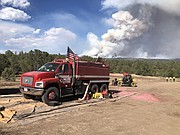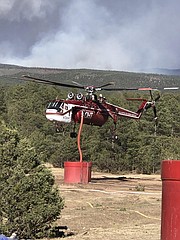Dispatches from the fire lines in New Mexico
I arrived at the Hermits Peak/Calf Canyon fires in North Central New Mexico on May 24 to relieve Ron Granger, owner and operator of Leviathan Inc., a type 1 water tender contracted with the Forest Service. A type 1 water tender is the largest type of water tender used by the Forest Service on wild land fires.
Pulling in to the sprawling busy base camp near the small town of Peco, New Mexico I was overwhelmed with the vast size of this base camp. Hundreds of vehicles were park in long columns that just returned from the night shift or getting ready to leave for the grueling day shift where 12-16 hour works days are the norm.
It’s time to setup my tent amongst a vast sea of tents wondering where I will be assigned to work, in what could be called a huge ant hill of activity.
Morning comes early and cold at 7,000 feet elevation in the mountains of New Mexico. With assignment in hand and with a hardy breakfast, my job takes me to a mobile retardant base [MRB]. The base is set up in a large meadow where special purpose trucks mix the fire retardant with water which is then pumped to large tanks ready for the incoming helicopters.
I am one of six water tenders that will be supplying water for several large helicopters called type 1s. These are the heavy lift helicopters, namely twin rotor Chinooks and single rotor Sky Cranes, that use suction tubes that take 1,500 gallons each time they fill. With 26000 gallons of water in the tenders and another 24,000 gallons in tanks, we start our day.
Weather forecasts call for winds of 20-30 mph with gusts of 50 mph and they turn out to be accurate today. We see large columns of smoke raising on the ridge across from my MRB. It looks like we are going to have a busy day. We know from years of experience that the fire is going to be most active between 1 and 6 p.m.
Hot Shot crews are shoring up the fire lines on the ridge across from us. They have parked their vehicles in a safe zone, or what we call a black zone, which this fire has recently burned over. The day is heating up and the smoke columns are getting huge, extending for several miles along the ridge tops. Radio chatter is increasing amongst the hot shot crew bosses.
I can tell things are not going as planned. The radio voices are covering each other. The Hot Shot bosses are calling over the radio for helicopter water drops near them and we are seeing the helicopters coming every few minutes, sometimes hovering in place for their turn at the tanks.
The 50,000 gallons of water we thought was sufficient to meet any emergency is being used faster than we can replace it. Today the average time to fill a water tender is up to an hour and 30 minutes in a very dry New Mexico.
The winds have pushed the fire back toward the Hot Shot crews and the order is given, get back to the vehicles and the safe zone. The fire and the Hot Shot crews arrive at the safe zone at the same time only to find that three of their vehicles are too close to the flames and will be left to be consumed by a fire that seems to have a mind of its own.
The three crews, now without vehicles, scramble to find rides to get to the closest other safe area, which is our mobile retardant base. The Hot Shot crews assemble at the backup safe zone and a head count is made to make sure everyone is accounted for. Vehicles can be replaced, People cannot.
This is a dangerous profession and today all the safety procedures worked perfectly. Nothing is worth the cost of a life. Not structures or equipment, nor trees or public infrastructure. We live today to fight fires another day.
Fighting fires is made up of many parts and it takes many people to keep all aspects of a fire camp running. This fire has almost 3,000 fire fighters working it with over 900 fire engines, 32 helicopters and over 200 water tenders.
Members of the wildland fire fighting business are one big family. We tend to see each other on many different fires no matter where in the U.S. they are. On this fire camp in Peco, New Mexico, I find vehicles from Alaska, Florida, New Jersey, and many other states.
It’s a call to serve, a way of life for many and gives you a sense of pride to be a member of such a united family that we call Wildland Fire Fighters.











